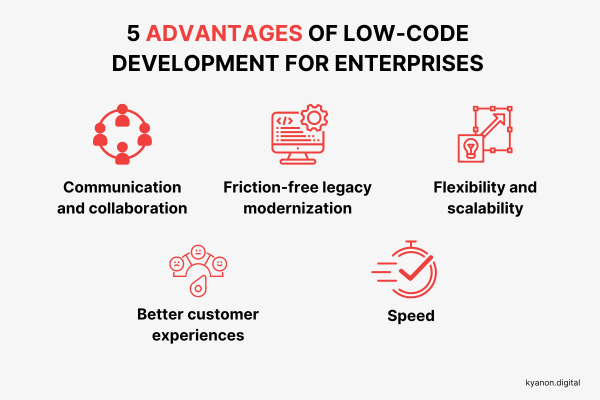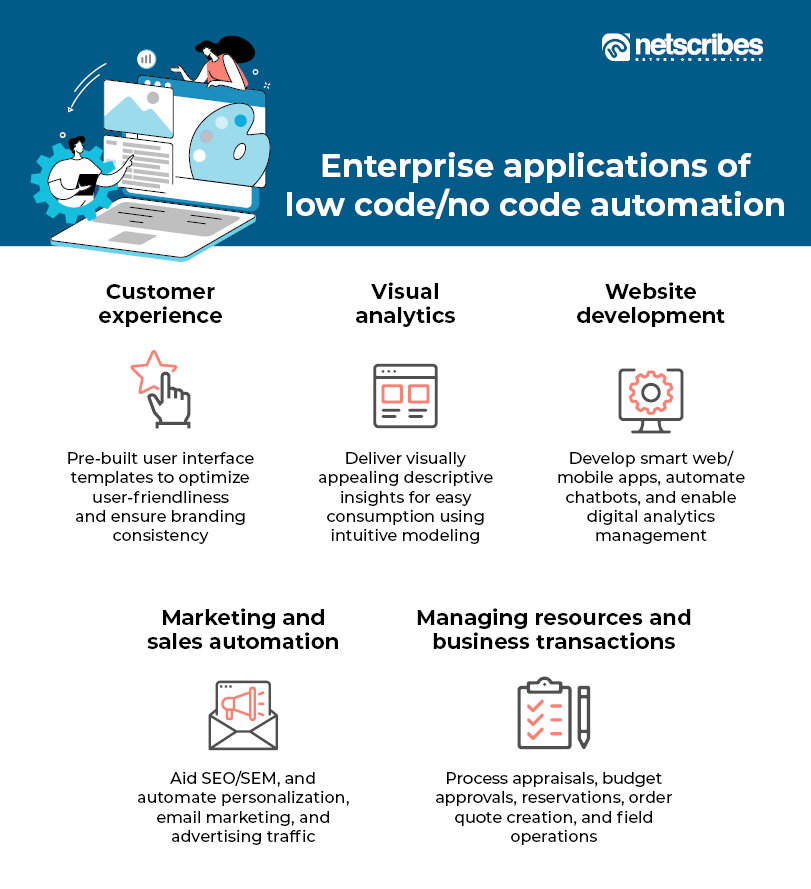Good Facts To Choosing Low-code platforms for application development
Wiki Article
Accessibility Of Low-Code Applications Is One Of The Biggest Advantages.
Due to a range of important factors, Low-Code Application Development is accessible to non-developers. These are known as "citizen designers."
Drag-and-Drop Builders: Low-code systems offer drag-and–drop interfaces which enable non-developers, without the need to write code, to develop visually-based applications. This lets development be more accessible to those with no technical backgrounds.
WYSIWYG: WYSIWYG editors are "What you see is what you Get" editors that allow users to create workflows and interfaces that are similar as the final product. It makes it much simpler to understand and use.
Simplified Workflow Design and Logic Design
Visual Workflow Modelling: Users are able to design business processes, application logic and flowcharts through models as well as visual flowcharts. These methods are more intuitive than the traditional coding methods.
Pre-built Logical Components: A lot of low-code platforms have built-in components for logic (e.g. loops, conditions) which can be easily configured. This eliminates the necessity to write complicated programs.
Reusable Components & Templates
Library of Pre-built Templates: Numerous low-code platforms have a library of templates for common applications, enabling non-developers to start with a solid foundation and modify as they need to.
Reusable modules and widgets by using modular or reusable widgets, the user can simplify the process of creating them by eliminating the need for extensive technical know-how.
Tutorials and guide development:
Step-by-Step Guides: Platforms usually provide guided development paths along with tutorials and suggestions to help non-developers with creating applications.
Interactive Tutorials Interactive tutorials are interactive and hands-on and help users learn by doing. This improves their confidence in the platform.
Integration with existing tools:
Seamless Integration: Low-code platforms are built to integrate seamlessly with the existing systems and tools in business (e.g. the CRM or ERP) that lets non-developers to develop applications that work with current workflows.
APIs Connectors: APIs integrate into apps to facilitate integration. This allows non-developers, with no programming skills, to connect with external services.
Collaboration Features:
Team Collaboration: real-time collaboration, shared workspaces, and shared workspaces permit non-developers, business analysts and other users to efficiently work alongside professional developers.
Role Based Access Control: You can give non-developers certain roles that have the right access level, so they can be part of the development process without compromise on security or function.
Automated Debugging, Testing and Debugging
Built-in Testing Tools: Platforms that are low-code typically have built-in testing tools and debugging tools that automate these procedures, making it simpler for non-developers to ensure their applications work correctly.
Platform highlights errors when they occur and offers fixes. This aids non-developers with troubleshooting.
In general, low-code application development can open up development to a wider audience. This is a major benefit for those who aren't developers. Through providing clear, intuitive tools and guided experiences, low-code applications allow users of business to participate actively in developing and maintaining applications, which bridges the gap between business requirements and technical implementation. View the most popular Low-code Platform for application development for blog examples including app modernisation, mobile app development platforms, cross platform mobile development, develop cross platform mobile app, rapid app development, microsoft azure sql, azure sql, application development platforms, low code development platforms, mobile development platforms and more.

Low-Code Application Development Offers Many Benefits In Terms Of Cost-Effectiveness.
The low-code approach to app development is a cost-effective option that offers many advantages. It's an excellent choice for companies looking to maximize their budgets as well as create quality apps. These are the main advantages reduced costs for development:
Lower Coding Requirements: Low coding platforms eliminate the need to write code manually, saving developers both time and money. This translates into lower costs for labor.
Fewer Developers: Because low code development is speedier and more simple and less complex, there are fewer developers needed. This reduces the need for cost of hiring and staffing.
Faster time to market
Rapid development cycle: Visual tools for development and pre-built components offered by platforms with low-code enable rapid application development, allowing companies to get their products on the market faster. This could lead to quicker revenue generation and better positioning in the market.
Rapid Prototyping: Businesses can quickly design and test prototypes, thus reducing the time required in the development stage and allowing for faster iterations based on user feedback.
Lower cost of maintenance:
Simpler maintenance: Low-code platforms, with their standardised components and modular architecture make them easier to maintain. This lowers the costs of ongoing maintenance.
Automated Updates: Many low-code platforms handle updates and patches automatically, ensuring applications remain secure and up-to-date without requiring large manual intervention.
Efficient Resource Utilization:
Contributions from non-developers Low-code platforms permit business users and non-developers alike to be part of the process of development. This democratization enables businesses to take advantage of the talents of a diverse range of employees.
Optimized Use of IT Resources: IT departments can focus on more strategic initiatives rather than being bogged down with routine development tasks which can increase overall efficiency and productivity.
The Scalable Pricing models
Subscription pricing: A lot of low-code platforms offer flexible pricing plans for subscriptions that scale with usage. This enables businesses to match their spending to their real needs and growth.
Pay-As-You-Go Options Certain platforms offer pay-as you-go options, which ensures that businesses only pay for the services they use, which can be particularly useful for small and new businesses with limited budgets.
Lowering Third-Party Costs of Software:
Built-in Functionalities : A low-code platform typically comes with built-in functions and integrations, which eliminates the requirement for additional third-party software, tools, and licenses.
Pre-Built integrations: These pre-built systems and services can be integrated with other popular services, which reduces the need for custom-built software and saves both time and cost.
Increased ROI
A faster return on investment: Rapid development and lower costs with speedier time to market can help businesses get higher return on their investment.
Increased Agility: Businesses are able to quickly adapt to market changes and demands of their customers and ensure that they remain relevant and can capitalize on emerging opportunities when they occur.
Lower Cost of Training:
Low-Code Platforms have User-Friendly Interfaces. The simple and user-friendly interfaces cut down on the learning curve of novice users. This reduces the requirement for extensive training programs.
Accessible Resources that are accessible. A lot of low-code platforms offer comprehensive training material including tutorials, training, and community assistance. They reduce the need to attend formal training which is costly.
Streamlined collaboration:
Enhanced collaboration Tools Collaboration tools are integrated into the workflow. This allows for better communication between team members as well as a reduction in project overhead.
Unified Development Environment (UDE): A single, unifying development environment streamlines workflows, reducing costs and complexity associated with managing multiple platforms and tools.
Low-code development is cost-effective since it decreases maintenance and development costs. It also speeds up the time to market and maximizes resource usage. Pricing models can be adapted. These elements provide substantial financial benefits to business and make low-code an attractive option for businesses who want to make the most of their budgets while delivering solid, reliable, high-quality applications. See the top rated Legacy application modernization with Low-code info for website tips including driver jdbc, rapid action development, lowcode no code, application development platforms, developing mobile apps, push notifications android, azure sql server, cloud software applications, azure sql server, push notifications android and more.

The Advantages Of Low-Code Development To Collaborate And Streamline Workflow
Low-code application development offers several advantages when it comes to collaboration and workflow, making it an ideal choice for businesses seeking to improve team efficiency and streamlining the development process. Here are a few benefits.
Unified Development Environment. Low-code platforms allow all team members to work in a single and integrated environment. This includes business analysts, developers and designers as well as stakeholder. It eliminates silos while fostering better communication.
Visual Development Tools - The drag-and drop visual nature of low code platforms allows for non-technical staff to take part in the development process. This makes sure that all business requirements are captured and implemented accurately.
Enhanced Communication
Real-Time Collaboration Many low-code platforms include real-time features, such as editing and commenting simultaneously or immediate feedback. This allows for continuous communication, and helps decrease the amount of time wasted in back-and forth discussions.
Workspaces shared by teams. Teams can collaborate on shared workspaces. In this workspace, they can review, edit, and discuss various project components.
Streamlined Workflow:
Built-in project management Tools: Lowcode platforms often come equipped with tools integrated to assist teams in planning, tracking and coordinating their progress. This includes tasks assignment, progress monitoring, and management of deadlines.
Workflow Automation: Automating routine tasks and workflows decreases the manual effort and mistakes and allows teams to focus on more strategic activities and improving overall efficiency.
Speedier Iteration cycles
Rapid prototyping. Low-code platform enables rapid prototyping. This allows for feedback to be quickly integrated into the application, and for rapid improvement.
Agile Development Support Supporting agile methodology allows teams and individuals to work in small steps. It allows them to rapidly adjust to changing circumstances.
Accessibility for those who are not developers
Citizens Development: Lowcode platforms enable users of business applications (citizen developers) to develop modifications, maintain, and create applications that do not require a lot of code. This lets IT and development teams to concentrate on other areas and be more responsive to business demands.
Training and Onboarding. The intuitive tools and the extensive training materials can help a new team member get up-to-speed, improving the overall level of collaboration.
Centralized Knowledge Sharing and Documentation:
Documentation is integrated: Low-code platforms usually come with the tools needed to create and maintain documentation within the platform, making it easy for all project information to be centralized.
Knowledge Repositories: Teams can develop and keep knowledge repositories, which include best practices, templates and reuseable components, helping to facilitate sharing of knowledge and reducing the duplicate work.
Consistency and standardization:
Standardized components: Using pre-built, standard components guarantees the sameness across applications, making it simpler for teams to comprehend and collaborate on various aspects of the project.
Governance and Compliance: The built-in governance structures ensure that every development adheres to the organizational guidelines and regulations, reducing the chance of non-compliance, and ensuring that applications adhere to quality standards.
Feedback Loops and Improvement Loops
Integrated Feedback Mechanisms - Low-code platforms are often equipped with integrated feedback mechanisms. These allow users to provide quick feedback about applications that can then be incorporated in the process of development.
Continuous Improvement: The ability of quickly iterating and deploying changes based on feedback will ensure that applications are constantly developed, while being in tune with the needs and objectives of users.
Visualization and reporting
Real-Time Analyses: The built-in reporting and analytics tools offer instantaneous insight into the project's performance, progress and user interaction, allowing for data-driven decisions.
Visual Workflow Mapping: Visual tools that map workflows can be utilized by teams to optimize workflows. This can help them pinpoint bottlenecks and areas to improve.
Low-code development can offer many benefits in regards to workflow and collaboration. It can bring diverse teams together, automate processes, improve communication, and boost collaboration. This leads to a more collaborative, agile and efficient development environment, which leads to better-quality applications.
